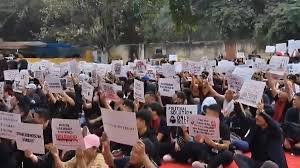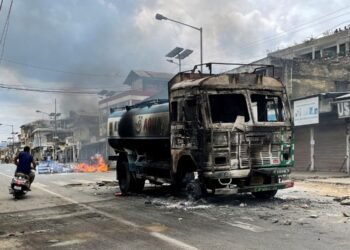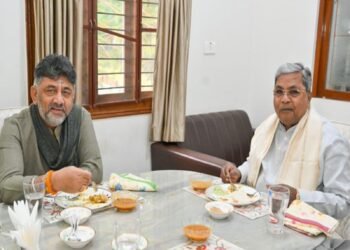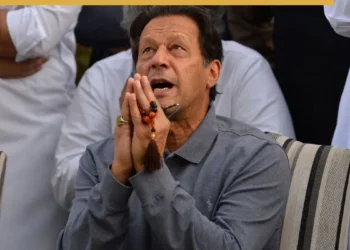From alleged militancy to frontline relief: Arambai Tenggol’s visible role during the Imphal floods has sparked both praise and suspicion in a deeply divided Manipur.
BY PC Bureau
June 1, 2025: In the wake of severe flooding that ravaged Imphal in late May 2025, an unexpected and controversial group emerged as one of the most visible responders: Arambai Tenggol. Known largely for its alleged role in Manipur’s ongoing ethnic conflict, the radical Meitei outfit—often associated with accusations of arms looting, assaults, arson, and even killings—was at the forefront of several rescue and humanitarian operations during the disaster.
The deluge, intensified by relentless rains and the remnants of Cyclone Remal, caused the Imphal, Iril, and Nambul rivers to overflow, inundating large swaths of the Imphal East and West districts. More than 10,000 residents were affected, with many forced into temporary relief camps. Critical institutions such as the Regional Institute of Medical Sciences (RIMS) and Jawaharlal Nehru Institute of Medical Sciences (JNIMS) were severely impacted, with rising water levels disrupting operations and putting patients at risk.
#ArambaiTenggol 🫡 🙏🙌💪
Brave and selfless youths from the Meitei community have always stepped forward to protect the people of Manipur in times of crisis, whether it be natural disasters or external threats.
Putting humanity above all, they even extended help to #RAF… pic.twitter.com/sIbTj7tvtE— Sanguine (@EnhancingChanu) June 1, 2025
Amidst the chaos, members of Arambai Tenggol were seen actively participating in relief efforts. Eyewitnesses and reports from X (formerly Twitter) described their collaboration with state and national agencies including the National Disaster Response Force (NDRF), State Disaster Response Force (SDRF), Manipur Fire Services, and Assam Rifles. Their presence was particularly noted in some of the worst-hit localities: Singjamei, Langthabal, Kshetrigao, Wangkhei, Heingang, Khurai, and Palace Compound.
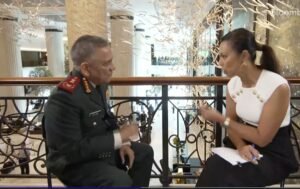 READ: After CDS Bombshell, Unanswered Questions Whip Up Storm
READ: After CDS Bombshell, Unanswered Questions Whip Up Storm
Their assistance appeared focused on vulnerable groups—elderly residents, schoolchildren, and stranded students. On May 31, when floodwaters inundated parts of JNIMS, Arambai Tenggol members reportedly assisted in the evacuation of critically ill patients, working alongside hospital staff and official responders. In a separate instance that same day in Imphal East, the group was credited with rescuing two teenagers who had drowned, a swift response applauded by local onlookers. In another widely shared report, Arambai Tenggol volunteers helped transport college students stranded in floodwaters back to their families.
Social media users also documented their efforts in assisting the elderly and children from submerged areas, particularly in Heingang and Palace Compound. Photos and videos circulating online depicted Arambai Tenggol members carrying residents through waist-high water, ferrying supplies, and helping people onto makeshift rafts. Some users hailed them as “frontline responders” amid what they described as an underwhelming state response.
The efforts of #ArambaiTenggol during the ongoing severe floods in Manipur exemplify the organization’s unwavering commitment to the welfare and safety of the Meitei community and beyond. As the floods wreaked havoc, displacing thousands and endangering lives, Arambai Tenggol… https://t.co/HSG2FTSOAc pic.twitter.com/6N5Mee3xyS
— Sauvik Raha (@SauvikRaha) June 1, 2025
Yet, not all responses were favorable. Some posts, particularly from Kuki-Zo users and activists, questioned the motives behind the group’s involvement, pointing to their history of alleged violence against tribal communities. In turns, Meiteis users linked the floods to deforestation in the hills, allegedly caused by Kuki-Zo settlements.
READ: A Warm Homecoming: Kashmiri Muslims Welcome Pandits to Mela
The floods presented a rare opportunity for Arambai Tenggol to reshape public perception and assert a community-first identity. Whether this signals a genuine transformation or a strategic pivot remains to be seen. In a state still grappling with the scars of ethnic violence and deep-seated mistrust, the true impact of such efforts may lie not only in the lives saved but in the narratives that follow.




